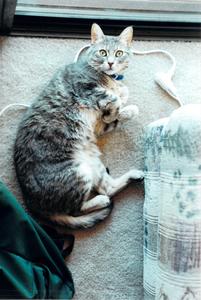

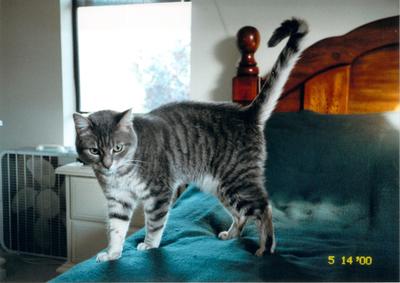
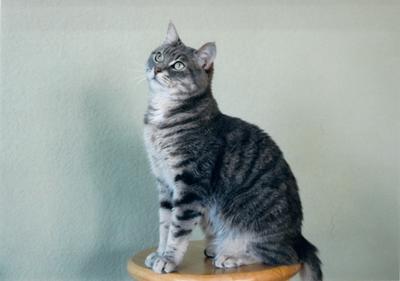
The first day we brought him home as a tiny kitten, he wouldn't eat. Now I think it was because of some combination of anesthesia (from the neutering) and his shots, which he had just received, but at the time, I didn't know why, and I was starting to get worried (although it had been less than a day). So I started experimenting with food from our dinner. Steak fat? Wouldn't touch it. Actual tasty steak? Nope. A few corn kernels? Bingo! I put a bunch in his food bowl and he gobbled them all up, carefully eating around that nasty kibble stuff. This was to be the beginning of some strange food preferences for Kirby. We have since discovered that some of the weirdest things he will eat are melon (cantaloupe and honeydew) and corn tortilla chips (even the ones with olestra), which are one of his favorite treats.
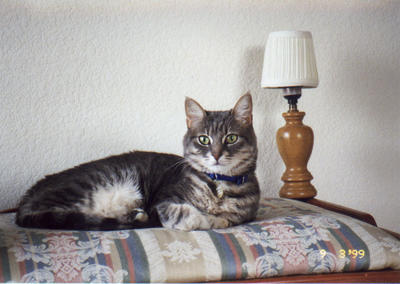
But, lure him into a game of "catch the radioactive red fly" (laser pointer), or pick up the cat dancer (bits of cardboard on stiff wire) and watch Kirby transform into the ultimate hunter. He flattens to the ground and stalks the "prey", attempting to blend in with the surrounding sea of beige carpet. This has earned him the nickname of "California Carpet Tiger". You can just imagine one of those nature film guys saying: "Now watch as the California Carpet Tiger blends in perfectly with the surrounding carpet and sofa. It's prey won't even see it coming."
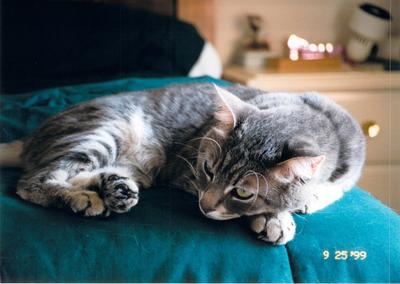
However, he is very good at going after fake "prey". Walking feet, dangling hands and Cammy (our other cat) are all also valid targets for Kirby when in hunt-mode. Catnip will also induce the hunt-mode in Kirby. Some new catnip in the toy, or a little sprinkled on the scratching post will cause him to "wig out" in a most impressive way. He will roll around in it, attack it (if it's a toy), or playfully attack the nearby Cammy, who is only too glad to escape. It's all very entertaining to watch.
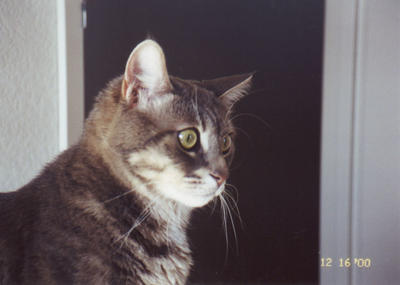
Kirby (like all of our pets) has a number of nicknames. The first was probably Fuzzy, because, well, he's fuzzy. He also goes by Kirb-Kirb, Kirbers, Kirbster, Fuzzy Guy, Fuzzy Butt, Fuzzers, Fuzzo, Mr. Fuzzo, Mr. Fuzz, Fuzz Butt, Fuzzle, Basket Kitty (because he likes to hop into empty laundry baskets), and the aforementioned California Carpet Tiger.
Kirby is now also known as "The Expensive Kitty" after his bout of Feline Lower Urinary Tract Disease (FLUTD), formerly known as Feline Urologic Syndrome (FUS). This condition, in which urinary crystals block the flow of urine from the urethra, can result in death if it is not treated. It almost always affects male cats because they have a more narrow urethra than females. For Kirby, the symptoms we saw were frequent, non-productive attempts to urinate in inappropriate locations (i.e., all over the house rather than in the litter box).
The first time it happened was a week to the day after we moved. We took him to a vet who kept him for a couple days while he had a urinary catheter in place to allow him to recover and all the crystals to come out. Then they sent us home with some Waltham Feline S/O Control pHormula Diet (a prescription food), which they said he would have to be on for the rest of his life. That was the first several hundred dollars.
The second time it happened was just about a month later, this time during the middle of the week. Since we only had one car at the time David had to leave work early so we could get him in to see the vet (a new vet this time). We told them he was already on the special Waltham food (which he didn't much care for anyway), but it didn't seem to matter. They kept him for another couple days with the urinary catheter and all that, then sent us home with Hills Prescription Diet Feline S/D, which is a different brand that is also supposed to promote urinary tract health. That was the second several hundred dollars.
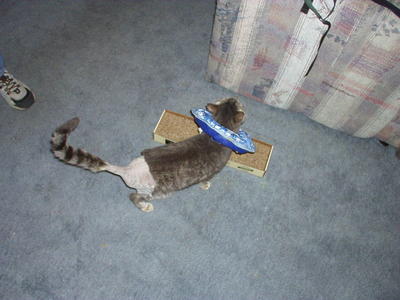
Since this was the third time in as many months, and despite being on the prescription diets, we decided to go ahead with the prineal urethrostomy surgery as a last resort. This surgery widens the urethral opening and has its own set of risks and complications, but it couldn't be worse than a poor kitty who was blocking up on a monthly basis. A week and several hundred dollars later, Kirby came home. Cammy became quite nasty towards him after he came back from the vet (each time), and any closeness they had before the ordeal has been lost. They now seem to share an uneasy truce, although one or the other will occasionally bat and/or hiss at the other one for seemingly no reason at all. But at least Kirby is well now, and has even passed his three- and six-month check-ups with flying colors.
It would seem that we are now in the clear. Nobody really knows what causes the crystals to form, although it usually is related to diet. In Kirby's case, at first I thought it was the stress from moving, but now I believe it was the fact that after moving we switched from a free-feeding schedule (which he had been on previously) to a fixed-feeding schedule (twice a day). He never did adjust, and despite getting yummy canned food, lost a lot of weight. Once I figured out someplace to put his food bowl so that Cammy couldn't get at it, he has once again gained back all the weight he lost and now looks great (after his hair grew back, which took quite some time). And this is despite being on a regular, commercial food (California Natural Chicken and Rice Dry) and not a special prescription food. With any luck, Kirby will be a healthy cat for years to come, although he has definitely earned the "Expensive Kitty" nickname.

And now to answer the question that got you started reading all this to begin with: If he doesn't "meow", what sound does Kirby make? As a small kitten, Kirby was very quiet. His only real vice (aside from attacking unsuspecting hands on or near the floor) was puncturing holes in cardboard or paper, as if he were trying to perforate it. In an effort to make Kirby a bit more vocal (anything is more vocal than no sound at all), I got out the cat treats and said "Fuzzy!" until he made a noise. I had hoped the noise would be a "meow", but he seemed incapable of that, and the only sound he did make sounded more like "a-a-a-a". Now that we have Cammy, who knows how to make a real "meow" noise, Kirby has picked it up a bit, and will now sometimes make plaintive wailing meows when he's hyper and needs to chase something (usually Cammy) or has spotted a bug that's out of reach. You can listen to Kirby make his signature "a-a-a-a" noise to get a kitty treat.
